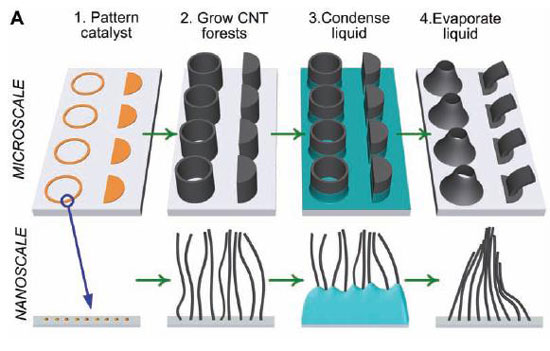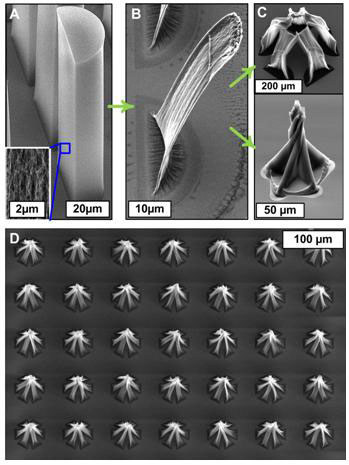| Dec 18, 2010 |
Innovative method to fabricate complex 3D microstructures
|
|
(Nanowerk News) Researchers from imec and the University of Michigan have reported a new technology to fabricate complex three-dimensional microstructures, with intricate bends, twists, and multidirectional textures, starting from vertically aligned carbon nanotubes (CNT) ("Diverse 3D Microarchitectures Made by Capillary Forming of Carbon Nanotubes"). The resulting assemblies have a mechanical stiffness exceeding that of microfabrication polymers, and can be used as molds for the mass production of 3D polymer structures. The method is straightforward, in that it requires only standard two-dimensional patterning and thermal processing at ambient pressure.
|
 |
| Illustration of CNT forest growth and capillary forming sequence.
|
|
Complex surfaces with precisely fabricated nanosized features are needed in, for example, metamaterials, substrates for cell culture and tissue engineering, smart active surfaces, and lab-on-a-chip systems. But existing methods of fabricating 3D microstructures all have their drawbacks, requiring tradeoffs in feature geometry, heterogeneity, resolution, and throughput. This new method, which the researchers have termed 'capillary forming', promises a path to robust, deterministic fabrication of intricate structures with high mechanical stiffness.
|
|
The approach to capillary forming of CNTs starts with patterning a catalyst layer on a silicon wafer, using optical lithography. Second, that layer is used to grow microstructures made of vertically aligned CNTs – CNT forests – through thermal chemical vapor deposition (CVD) at atmospheric pressure. Next, a solvent such as acetone is condensed on the substrate. This is done by positioning the substrate, with the CNT patterns facing downward, over a container with the boiling solvent. The solvent vapor rises through the container and condenses on the substrate. Due to capillary rise, the solvent is drawn into each CNT microstructure independently. After the substrate has been exposed to the vapor for the desired duration, it is removed from the container. As a result of the process of infiltration and evaporation of the solvent liquid, capillary forces will bundle the CNTs, resulting in a transformation of the initial 2D geometries into intricate 3D structures.
|
 |
| SEM image of CNT forests before (A) and after (B) capillary forming, as well as more complex arrangements of microstructures (C,D).
|
|
With this method, it is possible to construct robust 3D assemblies of filamentary nanostructures. The researchers have demonstrated this method through the fabrication of a library of diverse CNT microarchitectures. A bending motion, for example, can be combined into twisting and bridge-shaped architectures which cannot be made using standard lithography. This new approach to manipulate nanoscale filaments using local mechanical deformations makes it easier to deterministically design and fabricate 3D microarchitectures with complex geometries as well as nanotextured surfaces. Yet it only requires a standard patterning and thermal processing at ambient pressure.
|
|
This work received the Robert M. Caddell award for outstanding research in materials and manufacturing.
|


